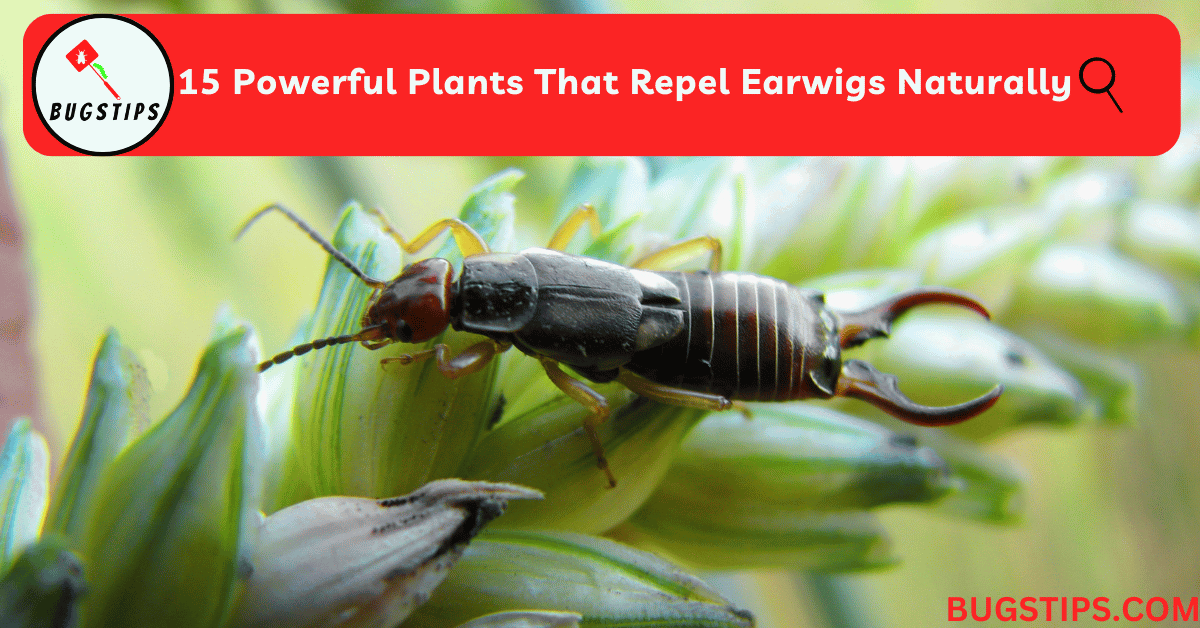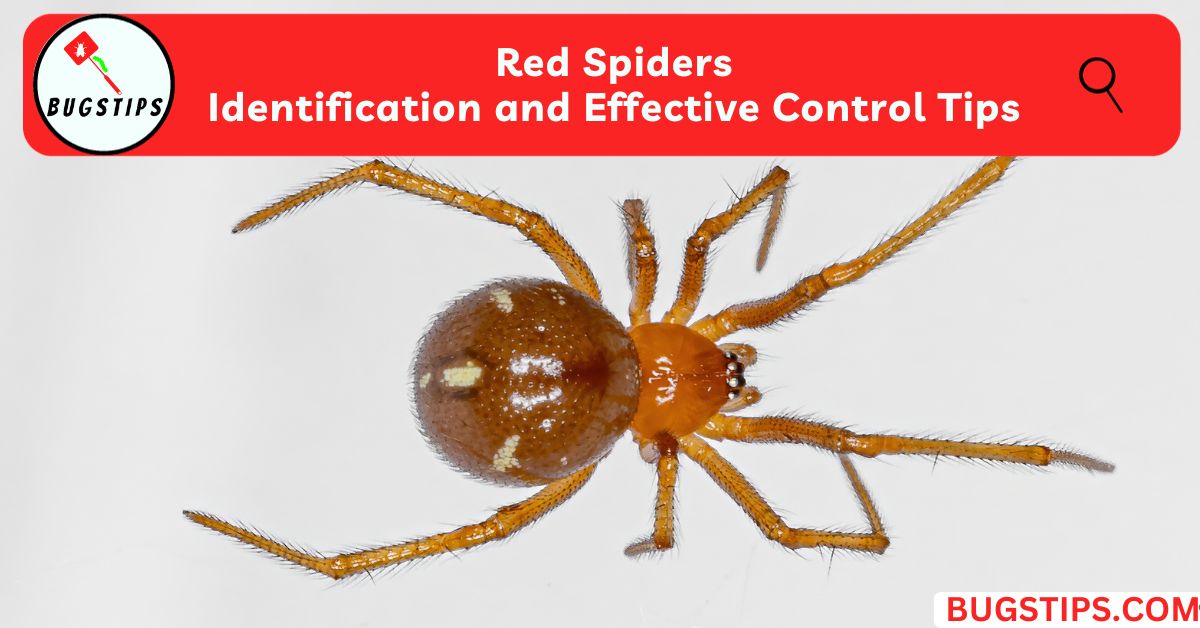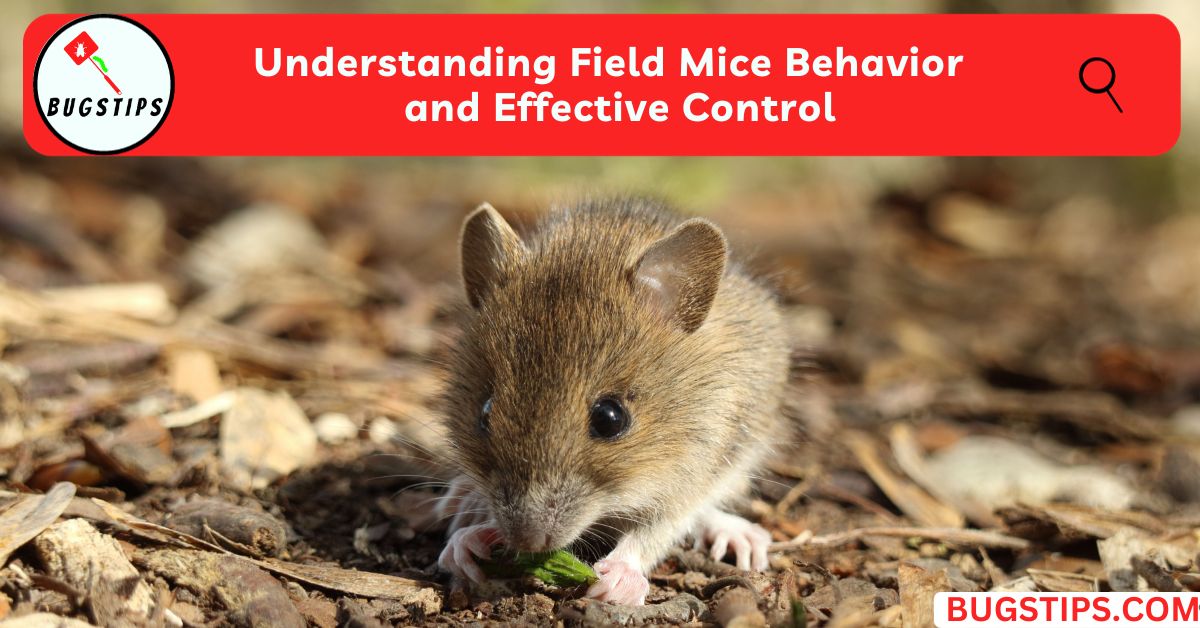This post may contain affiliate links which means as an Amazon Associate, this site may earn a small commission on qualified purchases made through links at no extra cost to you. Learn more on Affiliate Disclosure
If you’re a gardener, you know how frustrating it can be to see your plants damaged by pests. One such pest that can be particularly bothersome is the earwig. These small insects can wreak havoc on your garden and leave you feeling helpless.
However, you don’t have to resort to harmful chemicals to get rid of them. Natural remedies like plants can be just as effective, without putting your health or the environment at risk.
In this article, we’ll explore the benefits of using plants to repel earwigs and highlight some of the best options out there. From the aromatic Bay Tree to the pepperminty Peppermint, these plants not only keep earwigs away but also add beauty and fragrance to your garden.
So, let’s dive in and discover how to use Plants That Repel Earwigs!
Plants That Repel Earwigs
When protecting your garden from pesky earwigs, natural remedies can often be more effective than harmful chemicals. Luckily, there are plenty of plants that can repel these unwanted visitors.
So here we will explore a variety of plants that have been known to successfully repel earwigs. Each plant has unique characteristics and requirements, so read on to discover which plants may be best suited for your garden.
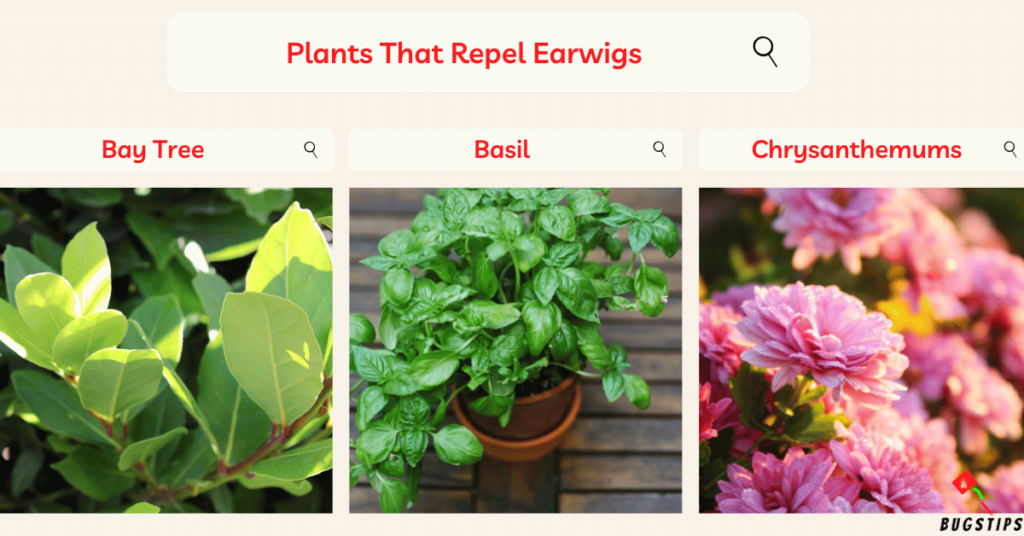
Bay Tree (Laurus nobilis)
Bay trees, also known as Laurus nobilis, are a popular plant for those who love to cook with fresh herbs. These trees have dense, dark green foliage that can add a touch of elegance to any garden. They can grow up to 30 feet tall and 15 feet wide, but can also be pruned to fit into smaller spaces. Bay trees are native to the Mediterranean region and require well-draining soil and full sun to thrive.
Apart from being a wonderful culinary herb, bay leaves have also been known to repel earwigs. The plant releases a scent that the earwigs find unpleasant, which deters them from entering your garden.
Related Article – Do Coffee Grounds Repel Earwigs?
Simply plant bay trees around the perimeter of your garden to create a natural barrier that will keep earwigs at bay.
Alternatively, you can also use fresh or dried bay leaves to make a natural insect-repellent spray. Simply steep the leaves in hot water for a few minutes, let them cool, and then spray them around the garden.
Bay trees are not only useful for repelling earwigs, but they also attract beneficial insects such as bees and butterflies. They also have a long lifespan and can live for up to 50 years, making them a great investment for any garden.
So if you’re looking for a beautiful and valuable addition to your garden that can repel earwigs and attract beneficial insects, consider planting a bay tree.
Basil (Ocimum basilicum)
Basil, also known as sweet basil, is a popular herb that is widely used in cooking. However, it’s not just its flavor that makes it popular. Basil is also a natural repellent for earwigs.
Basil plants have a distinct aroma that can be described as sweet and spicy. This aroma is what makes it effective in repelling earwigs. When planted in the garden, the scent of the basil plant acts as a natural deterrent for these pesky insects.
To grow basil, you need to plant it in a location that receives at least six hours of sunlight each day.
It also requires well-draining soil that is rich in organic matter. Basil plants should be watered regularly, but care should be taken not to overwater them.
Basil is a versatile herb that can be used in many dishes, including pasta sauces, soups, and salads. And not only is it delicious, but it also has many health benefits. It’s a good source of antioxidants and has anti-inflammatory properties.
If you want to repel earwigs naturally, consider planting basil in your garden. Not only will you be able to enjoy its delicious flavor, but you’ll also be able to keep these pesky insects away.
Chrysanthemums
Chrysanthemums are not only beautiful, but they can also serve as a natural defense against earwigs. These plants contain a chemical compound called pyrethrum, which is commonly used in insecticides.
However, in the case of chrysanthemums, the compound is found in its natural state and can be used to repel earwigs without harming other insects or animals.
Chrysanthemums are easy to grow and require full sun and well-drained soil. They come in a variety of colors and sizes, making them a great addition to any garden.
To use chrysanthemums as a natural earwig repellent, plant them around the perimeter of your garden or in areas where earwig activity is high.
It’s important to note that while chrysanthemums can repel earwigs, they can also attract other insects such as aphids.
To avoid this, it’s best to regularly inspect your chrysanthemums for any signs of infestation and to remove any affected leaves or flowers.
With proper care, chrysanthemums can serve as a natural and effective way to keep earwigs at bay.

Common wormwood (Artemisia absinthium)
Common wormwood, or Artemisia absinthium, is a perennial plant that is native to Europe, Asia, and North Africa. It has a strong, bitter scent and is often used as a natural insect repellent.
The plant can grow up to 4 feet tall and has silvery-green leaves that are deeply lobed.
Growing wormwood is easy, as it can adapt to a variety of soil types and light conditions. It prefers well-draining soil and full sun exposure, but it can also thrive in partial shade. The plant is drought-tolerant and does not require frequent watering.
Wormwood is effective at repelling a variety of insects, including earwigs. Its strong scent is believed to mask the attractive pheromones that earwig use to communicate and mate, making it an effective deterrent.
However, it is important to note that wormwood should be used with caution, as it can be toxic in large amounts. It is not recommended for consumption or for use around pets or children.
Coriander (Coriandrum Sativum)
Coriander, also known as cilantro, is a popular herb in many kitchens. This versatile plant can also be used to repel earwigs in your garden.
Coriander has a unique fragrance that is unpleasant to earwigs, making it an effective natural repellent.
Coriander plants prefer a cool and moist environment, making them a perfect addition to a garden bed or container. They require well-draining soil and regular watering to thrive. Coriander can also be grown indoors in a sunny window.
To use coriander as a natural earwig repellent, plant it around the edges of your garden beds or in pots around your patio.
You May Also Like – How to Keep Earwigs Out of Sandbox
You can also make a spray by steeping coriander leaves in hot water and straining the liquid. Spray this solution directly on the plants or affected areas in your garden to deter earwigs from congregating.
Dill (Anethum Graveolens)
Dill (Anethum Graveolens) is a popular herb that not only adds a distinctive flavor to dishes but also has the ability to repel earwigs.
This herb is easy to grow and can reach up to 3 feet in height, making it a great addition to any garden. Its leaves are feathery and bright green, while its flowers are yellow and small.
To grow dill, plant it in well-drained soil and in an area that receives full sun. It is important to water it regularly and to ensure that the soil does not dry out completely.
Dill is also known to attract beneficial insects, such as lacewings and ladybugs, which can help to control other garden pests.
Dill repels earwigs due to their strong scent, which masks the scent of other plants that earwigs may be attracted to.
Planting dill near other plants that are prone to earwig infestations can help to prevent an infestation from occurring. Additionally, dill can be dried and used to make sachets that can be placed in areas where earwigs are likely to enter, such as windowsills and doorways.

Fennel (Foeniculum Vulgare)
Fennel (Foeniculum Vulgare) is another herb that can be useful in repelling earwigs. Fennel is a tall, feathery plant that can grow up to 6 feet tall, and has a licorice-like scent. It is easy to grow and thrives in well-drained soil and full sun.
Fennel repels earwigs by emitting a scent that they find unpleasant. The plant also attracts beneficial insects such as ladybugs and lacewings, which are natural predators of earwigs.
To use fennel as a natural repellent, plant it around the perimeter of your garden or near areas where earwigs are known to gather.
You can also dry the fennel and use it to make sachets to place in areas where earwigs are present, such as under rocks or in garden beds.
Overall, fennel is a great choice for gardeners looking for a natural way to repel earwigs while also attracting beneficial insects to their garden.
Garlic (Allium Sativum)
Garlic (Allium Sativum) is not only a popular herb in cooking, but it also has the ability to repel earwigs. This pungent-smelling plant contains sulfur compounds that can mask the scent of other plants, making them less attractive to earwigs.
Garlic can be grown in containers or directly in the garden, and it prefers well-draining soil and full sun.
To use garlic as a repellent, simply plant it around the perimeter of your garden or in areas where earwigs are commonly found. Alternatively, you can make a garlic spray by steeping crushed garlic cloves in water and spraying it on plants.
It’s important to note that while garlic can repel earwigs, it can also repel beneficial insects such as ladybugs and lacewings, so use it sparingly and strategically.
You May Also Like – Earwigs in Mailbox? 8 Proven Ways to Keep Them Out
Lavender (Lavandula)
Lavender, with its distinctive purple flowers and relaxing scent, is not only a popular ornamental plant but also a natural repellent for earwigs. Lavender plants are low maintenance and easy to grow, making them a great addition to any garden.
They prefer full sun and well-drained soil and can be planted as borders, hedges, or in containers.
The fragrance of lavender is what repels earwigs. The scent is pleasant to humans but not to the earwigs, who find it overwhelming.
By planting lavender around the perimeter of your garden, you create a natural barrier that will deter earwigs from entering. Additionally, the aromatic oils found in lavender can also repel other garden pests, such as aphids and moths.
To make the most of lavender’s repellent properties, it’s best to plant it in areas where earwigs are likely to enter, such as near doors, windows, and other entry points. You can also crush some of the leaves and flowers to release more of the scent or make a lavender sachet to hang in problem areas.

Nasturtiums (Tropaeolum)
Nasturtiums (Tropaeolum) are beautiful flowering plant that is popular among gardeners for their bright and vibrant colors. They are also known for their ability to repel a variety of pests, including earwigs.
These plants have a pungent odor that is unpleasant to many insects, including earwigs, and can effectively keep them away.
Nasturtiums are easy to grow and can be planted directly in the ground or in containers. They prefer full sun to partial shade and well-drained soil. They are a great option for garden borders or as a ground cover, and can also be grown in hanging baskets or pots.
In addition to repelling earwigs, Nasturtiums are also a favorite of many beneficial insects such as ladybugs and hoverflies, which can help to control other garden pests.
They are also edible and can be used in salads or as a garnish, making them a versatile addition to any garden.
Onions (Allium Cepa)
Onions (Allium cepa) are a common ingredient in many recipes, but did you know they can also repel earwigs from your garden? Onions are easy to grow and can be planted from seeds or sets. They prefer full sun and well-draining soil.
Earwigs are repelled by the strong smell of onions, making them an effective natural deterrent. To use onions to repel earwigs, plant them around the edges of your garden or in between other plants.
You can also make a homemade onion spray by blending a few onions with water and spraying the mixture on the plants you want to protect.
Not only do onions repel earwigs, but they also have other benefits for your garden. They can help repel other pests and improve soil health. Plus, you’ll have fresh onions to use in your cooking!
You May Also Like – What Do Earwigs Eat?
Peppermint (Mentha x piperita)
Peppermint (Mentha x piperita) is a popular herb that is known for its strong scent and refreshing taste. This plant is easy to grow and requires minimal maintenance, making it a great addition to any garden. Peppermint also has the ability to repel earwigs, making it a useful plant to have around.
Peppermint plants typically grow up to 2 feet tall and produce small purple flowers in the summer. They prefer well-draining soil and partial shade, although they can also tolerate full sun.
Peppermint leaves can be harvested and used fresh or dried for a variety of culinary and medicinal purposes.
The strong scent of peppermint is what makes it effective in repelling earwigs. The plant’s essential oil contains compounds that repel a variety of insects, including earwigs.
Simply planting peppermint in your garden or placing fresh peppermint leaves around your home can help keep earwigs at bay.
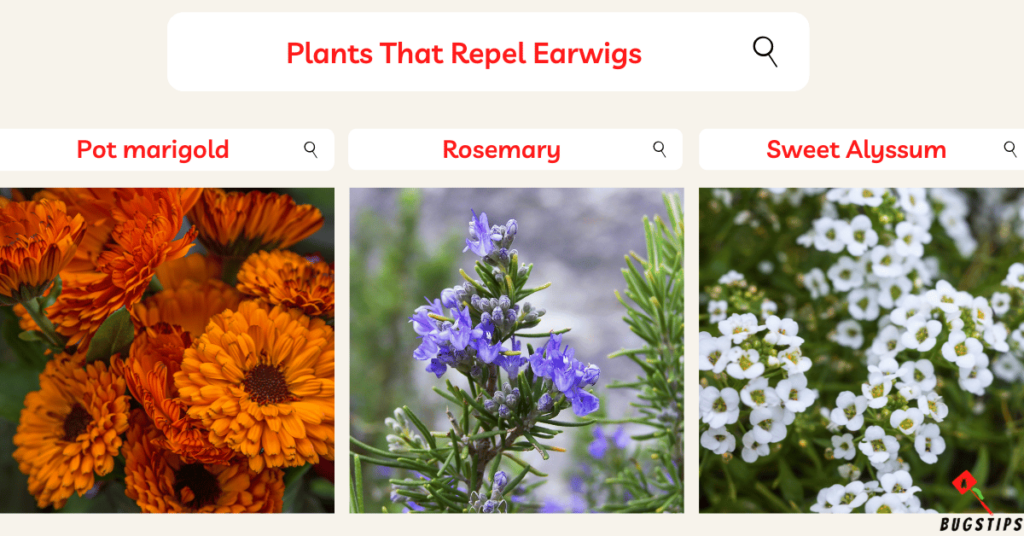
Pot marigold (Calendula officinalis)
Pot marigold, also known as Calendula officinalis, is a popular annual plant that is native to the Mediterranean region but can now be found in many parts of the world. The plant has bright yellow to orange petals that are long and thin, and it can grow up to 2 feet tall.
Pot marigold prefers full sun and well-draining soil. It can be grown from seeds and usually blooms from mid-spring to fall. It is known to repel many garden pests, including earwigs.
The strong scent of pot marigold is what helps repel earwigs. The plant contains natural compounds that are unpleasant to the insects, causing them to avoid the area.
Planting pot marigolds around the perimeter of the garden or near plants that are prone to earwig infestations can help deter these pests. Additionally, the plant is easy to care for and can add a pop of color to the garden with its vibrant blooms.
Rosemary (Rosmarinus officinalis)
Rosemary (Rosmarinus officinalis) is a woody, perennial herb with fragrant, needle-like leaves and small, blue, or purple flowers. It is a popular herb for cooking and can be found in many gardens.
Rosemary grows best in well-drained soil and full sun and can be propagated from stem cuttings or seeds. It is known for repelling a variety of pests, including earwigs, due to its strong scent.
The aroma of rosemary is thought to deter earwigs by masking the scent of other plants that they are attracted to. In addition, rosemary contains compounds such as camphor, cineol, and borneol, which have insecticidal properties that may also contribute to its effectiveness in repelling earwigs.
To make the most of its repelling properties, plant rosemary near the areas of your garden that are most prone to earwig infestations, or use it as a border plant around the perimeter of your garden.
Rosemary is a versatile plant that not only repels earwigs but also attracts pollinators such as bees and butterflies to your garden.
It is also a low-maintenance plant that requires little watering or fertilizer, making it an excellent choice for busy gardeners. With its many benefits, including its ability to repel earwigs, rosemary is a valuable addition to any garden.
Related Article – Earwigs in Bed? Here’s How to Keep Them Out
Sweet Alyssum (Lobularia Maritima)
Sweet Alyssum (Lobularia Maritima) is a low-growing plant that produces small, sweet-smelling white or pink flowers. It’s a popular plant for borders, edging, and rock gardens due to its attractive appearance and the fact that it’s easy to grow.
Sweet Alyssum repels earwigs by producing a chemical that they find unappealing. This chemical, called coumarin, is found in the plant’s leaves and stems.
Earwigs will avoid areas where Sweet Alyssum is growing, making it a useful addition to gardens that are prone to earwig infestations.
Sweet Alyssum prefers full sun to partial shade and well-drained soil. It can be grown from seed or purchased as seedlings from a nursery or garden center.
It’s important to keep the soil moist during the growing season, but the plant can be somewhat drought-tolerant once established. Sweet Alyssum is an annual plant that typically blooms from late spring to early fall.
How to Use Plants That Repel Earwigs
Earwig infestations can be a nuisance in gardens, but incorporating plants that repel them can be an effective and natural solution.
Here’s how to use plants that repel earwigs in your garden.
- Planting and caring for these plants is relatively simple. Most of them thrive in well-draining soil with regular watering and adequate sunlight. Some, like garlic and onions, can be planted directly in the ground, while others, like basil and peppermint, do well in containers.
- When deciding where to place these plants in your garden, consider areas where earwigs are commonly found, such as around moisture-retaining objects like rocks, flower pots, or piles of debris. Planting these repellent plants around these areas can help keep earwigs away.
- To maximize the effectiveness of these plants, consider planting a variety of them throughout your garden. Additionally, regularly pruning and harvesting your plants can help release their natural oils and scents, which are what repel earwigs.
Incorporating plants that repel earwigs can be an easy and effective way to keep your garden pest-free without using harmful chemicals. With a little planning and care, you can create a beautiful and functional garden that repels earwigs naturally.
Final Thoughts
Earwigs can be a nuisance, but there are natural and effective ways to repel them. Using plants that repel earwigs is a safe and eco-friendly solution that can be used both indoors and outdoors. Lavender, mint, rosemary, nasturtiums, and chrysanthemums are just a few of the plants that can help keep these pests away.
By using these plants and following the tips outlined in this article, you can enjoy a pest-free home and garden.
Plants that repel earwigs are a great way to keep these pests at bay without using harmful chemicals. Try planting some of these plants around your home and garden to see how effective they can be.
FAQs
How do I know if I have an earwig infestation?
You can identify an earwig infestation by looking for signs of damage to plants or garden areas. You may also see earwigs crawling around your home or garden.
Can I use these plants indoors to repel earwigs?
Yes, you can use these plants indoors to repel earwigs. Simply plant them in pots and place them near windows or doorways to keep earwigs away.
How often do I need to replant these plants?
Most of these plants are perennials and will come back every year. However, you may need to replace them if they become damaged or stop producing their natural repellent oils.
Resources – (for further reading)
Encyclopedia Britannica – Bay tree, Basil, Chrysanthemums, Common wormwood, Coriander, Dill, Fennel, Garlic, Onions
Wikipedia – Lavandula, Tropaeolum, Peppermint, Calendula Officinalis, Rosemary
North Carolina State University – Lobularia maritima (Alyssum, Sweet Alyssum)

